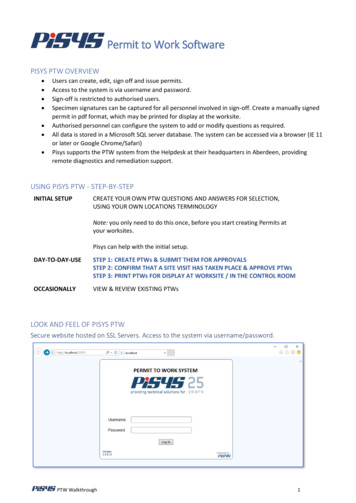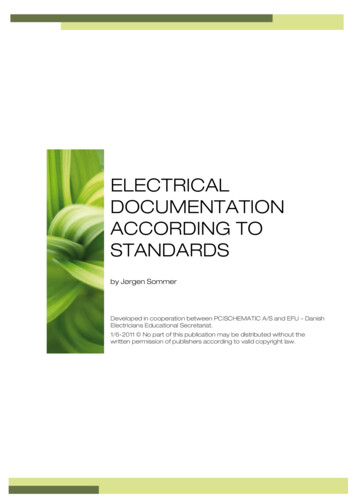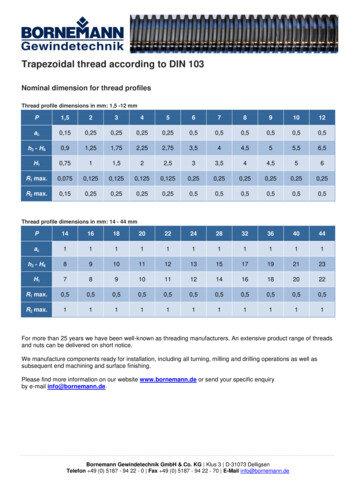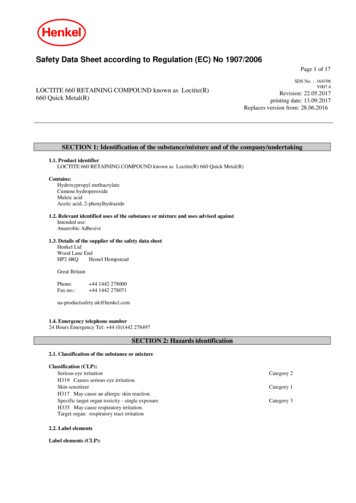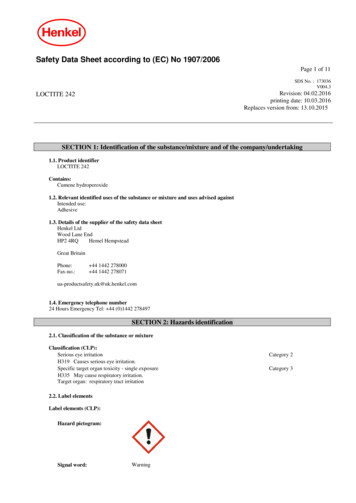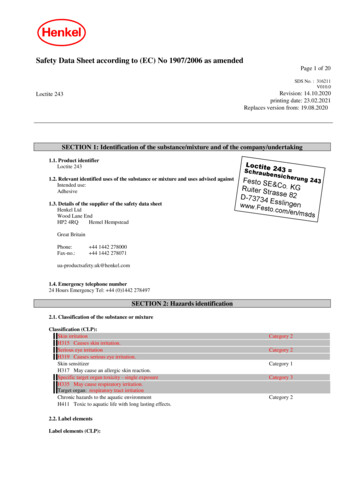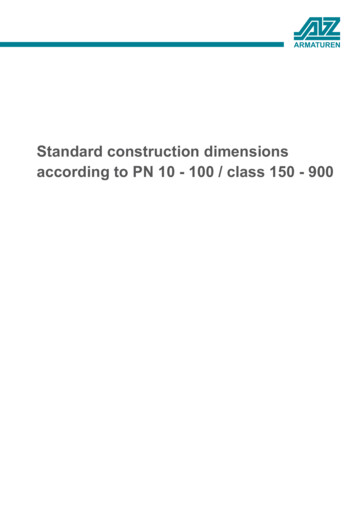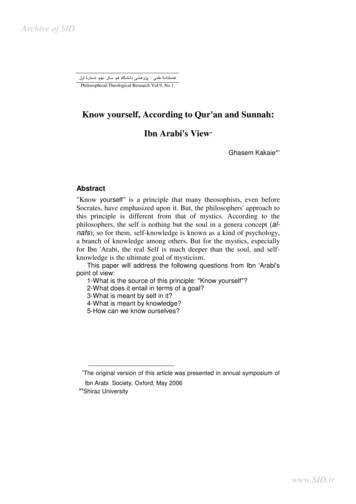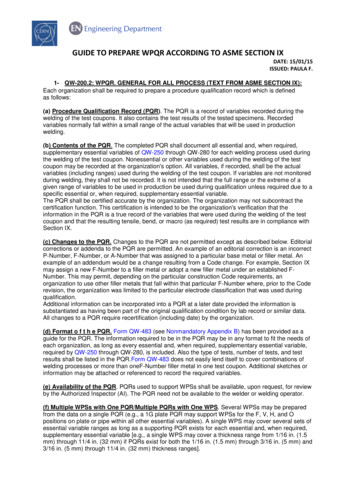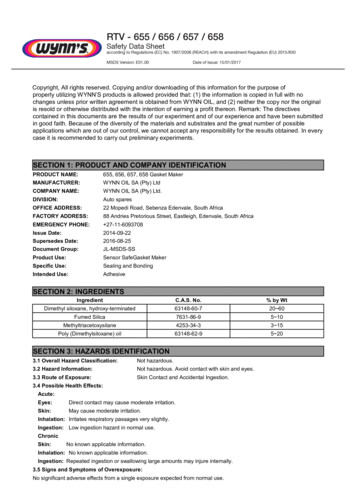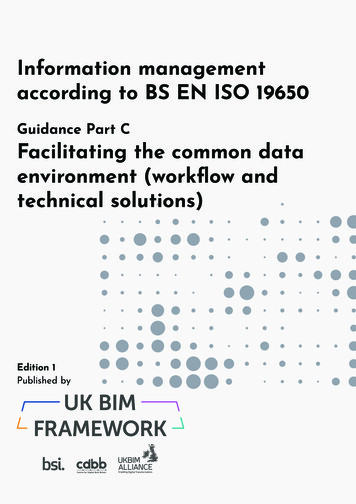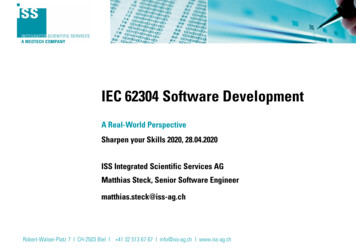
Transcription
IEC 62304 Software DevelopmentA Real-World PerspectiveSharpen your Skills 2020, 28.04.2020ISS Integrated Scientific Services AGMatthias Steck, Senior Software z 7 I CH-2503 Biel I 41 32 513 67 67 I info@iss-ag.ch I www.iss-ag.ch
IEC 62304 VersionsIEC 62304:2006 /EN 62304:2006Edition 1.0Harmonized for MDDIEC 62304:2006/Amd1:2015 /EN 62304:2006/Amd1:2015Edition 1.1FDA Recognized Consensus StandardState of the artIEC 62304:20xxEdition 2.0Work in progressRobert-Walser-Platz 7 I CH-2503 Biel I 41 32 513 67 67 I info@iss-ag.ch I www.iss-ag.ch
Basic ConceptsSoftware is anything that is executed on a processor or by an interpreter; its the thingyou cannot touch but which makes the other thing that you can touch do the thing youwant*: Application Software on a PC Mobile App on a phone Firmware / Embedded Software inside a device FPGA Source Code – Configurable hardware that is “programmed” (as of Amd1:2015)* the computer does what you tell it to do, not what you want it to doRobert-Walser-Platz 7 I CH-2503 Biel I 41 32 513 67 67 I info@iss-ag.ch I www.iss-ag.ch
Embedded software or Medical Device Software is software that is part of aphysical medical device and is designed for a specific hardware.Standalone software or Software as a Medical Device (SaMD) is software that isnot part of a physical medical device and is designed to run on a generichardware/software platform. The software is a medical device in itself.Where the platform is the combination of hardware and software that is not part of thehealth software, but is required to run it; e.g. operating system, system libraries.Note: The Medical Device Coordination Group (MDCG) uses the term Medical DeviceSoftware (MDSW) for both, embedded and standalone software.Robert-Walser-Platz 7 I CH-2503 Biel I 41 32 513 67 67 I info@iss-ag.ch I www.iss-ag.ch
SOUP (Software of Unknown Provenance) Software item that is already developed and generally available and that has notbeen developed for the purpose of being incorporated into the medical device (alsoknown as “off-the-shelf-software” or “3rd party component”). Software item previously developed for which adequate records of the developmentprocesses are not availableNote: Usually integrated into a product to reduce development time and cost and/or notto re-invent the wheel.Note: The standard defines requirements and activities regarding the use of SOUP,adding SOUP thus also incurs some effort and costs.Robert-Walser-Platz 7 I CH-2503 Biel I 41 32 513 67 67 I info@iss-ag.ch I www.iss-ag.ch
Product ImplementationFirst loop is developmentSubsequent loops are maintenanceRobert-Walser-Platz 7 I CH-2503 Biel I 41 32 513 67 67 I info@iss-ag.ch I www.iss-ag.chDecommission
Medical Software LifecyclePost stingDesignImplementationPost MarketDecommissionRobert-Walser-Platz 7 I CH-2503 Biel I 41 32 513 67 67 I info@iss-ag.ch I www.iss-ag.ch
Development Models Multiple ways to develop software exist, each one with advantages anddisadvantages Not all are suited for all environments; e.g. medical devices People can get a bit religious about themV-ModelWaterfallRobert-Walser-Platz 7 I CH-2503 Biel I 41 32 513 67 67 I info@iss-ag.ch I www.iss-ag.chAgile / Iterative
IEC 62304 / EN 62304 at a Glance The IEC 62304 is a process standard, it defines requirements to the development butnot the product itself. Evidence of the correct application of the standard, i.e. performing the requiredactivities, is the documentation Does not want to force a development model / process (e.g. Waterfall, V-model,SCRUM), but Robert-Walser-Platz 7 I CH-2503 Biel I 41 32 513 67 67 I info@iss-ag.ch I www.iss-ag.ch
Robert-Walser-Platz 7 I CH-2503 Biel I 41 32 513 67 67 I info@iss-ag.ch I www.iss-ag.ch
Different View (embedded software)QMSISO 13485Product DevelopmentMedical Electrical EquipmentIEC 60601 SeriesUsability EngineeringIEC 62366Software Life CycleIEC 62304Risk ManagementISO 14971Robert-Walser-Platz 7 I CH-2503 Biel I 41 32 513 67 67 I info@iss-ag.ch I www.iss-ag.ch
Different View (standalone software)QMSISO 13485Product DevelopmentHealth SoftwareIEC 82304-1Usability EngineeringIEC 62366Software Life CycleIEC 62304Risk ManagementISO 14971Robert-Walser-Platz 7 I CH-2503 Biel I 41 32 513 67 67 I info@iss-ag.ch I www.iss-ag.ch
IEC / EN 62304IEC / EN 60601-1IEC 82304-1Coverage of IEC 62304 and IEC 82304-1Robert-Walser-Platz 7 I CH-2503 Biel I 41 32 513 67 67 I info@iss-ag.ch I www.iss-ag.ch
Risk Based ApproachThe standard defines three software safety classes: Class A: No injury or damage to health is possible Class B: Non-serious injury is possible Class C: Death or serious injury is possibleThe software safety class applies to the software as a whole, but may optionally beapplied to individual or groups of software modules or components, e.g. low-riskcomponents may fall into a lower safety class.The software safety class is defined by the potential harm emanating from the software,regardless of the probability of the harm actually occurring.Note: Software safety class is independent from the medical device classification(Europe) and the level of concern (FDA); all of them are risk-based though.Robert-Walser-Platz 7 I CH-2503 Biel I 41 32 513 67 67 I info@iss-ag.ch I www.iss-ag.ch
The software safety class determines which lifecycle activities need to be performed forthe specific part of the software:Robert-Walser-Platz 7 I CH-2503 Biel I 41 32 513 67 67 I info@iss-ag.ch I www.iss-ag.ch
The software safety class should be determined through risk and hazard analysis:Robert-Walser-Platz 7 I CH-2503 Biel I 41 32 513 67 67 I info@iss-ag.ch I www.iss-ag.ch
Software Safety Classification As early as possible as it determines the activities required If not known (e.g. risk management not done yet) assume safety class C For the residual risk, only consider risk control measures external to the softwareThe standard essentially assumes that if the software fails, it fails catastrophically,i.e. negating software-based risk control measures.Note: The standard states that “Probability of a software failure shall be assumed to be1”, this only concerns the software safety classification and not failure probability for riskmanagement or in generalRobert-Walser-Platz 7 I CH-2503 Biel I 41 32 513 67 67 I info@iss-ag.ch I www.iss-ag.ch
Software Safety ClassificationSoftware items with a lower safety class mustnot be able to adversely affect software itemsof a higher safety class; the manufacturermust provide rationale for the segregationbetween such items. If this is not possible, theitems cannot be in a lower safety class.Software System / Software Item(Class C)Software ItemX(Class A)Also software-based risk control measurestake the safety class of the risk they’recontrolling.Robert-Walser-Platz 7 I CH-2503 Biel I 41 32 513 67 67 I info@iss-ag.ch I www.iss-ag.chSoftware ItemY(Class C)Software ItemW(Class B)Software ItemZ(Class C)
Processes defined by the IEC 62304: Software development (section 5) Software maintenance (section 6) Software risk management (section 7) Software configuration management (section 8) Software problem resolution (section 9)Robert-Walser-Platz 7 I CH-2503 Biel I 41 32 513 67 67 I info@iss-ag.ch I www.iss-ag.ch
PlanDoRobert-Walser-Platz 7 I CH-2503 Biel I 41 32 513 67 67 I info@iss-ag.ch I www.iss-ag.chVerify
Software Development es outside of the scope of this standardSystem development activities (including risk management)7 Software risk n5.4Software detaileddesign5.5Software unitimplementationand verification5.6Softwareintegration andintegration testing8 Software configuration management9 Software problem resolutionRobert-Walser-Platz 7 I CH-2503 Biel I 41 32 513 67 67 I info@iss-ag.ch I www.iss-ag.ch5.7Software systemtesting5.8Software release
Software Maintenance s outside of the scope of this standardSystem maintenance activities (including risk management)7 Software risk management6.1Establish softwaremainenance plan6.2Problem ign5.4Software detaileddesign5.55.6Software unitSoftwareimplementationintegration andand verificationintegration testing6.3 Modification implementation8 Software configuration management9 Software problem resolutionRobert-Walser-Platz 7 I CH-2503 Biel I 41 32 513 67 67 I info@iss-ag.ch I www.iss-ag.ch5.7Software systemtesting5.8Software release
Software Risk Management ProcessRisk Management with a software perspective: Identify software items that could contribute to a hazardous situation and identify thepotential causes Define and implement risk control measures Verify risk control measures (implemented and effective) Performed during development and maintenance activities; e.g. design changes mustbe analyzed for their impact on the patient risk (new risks, impact on existing risks orrisk control measures)Note: IEC 62304 mandates risk management according to ISO 14971Note: Software developers are not risk managers! They can and should be part of the riskmanagement team as subject matter experts though.Robert-Walser-Platz 7 I CH-2503 Biel I 41 32 513 67 67 I info@iss-ag.ch I www.iss-ag.ch
Configuration Management ProcessIdentify the inputs (and environment) from which a specific output has been developed: Establish means to identify configuration items (traceability) Techfile documents as defined in the document plan Source code as maintained in the version control system Toolchain, SOUP, and other inputs as defined in the configuration manualNote: The configuration of a software release is essentially a snapshot of all the inputsand the generated output, including all relevant documents of the techfile.Robert-Walser-Platz 7 I CH-2503 Biel I 41 32 513 67 67 I info@iss-ag.ch I www.iss-ag.ch
Problem Resolution ProcessHandle problems found during development or in the field: Prepare problem report for each problem found Investigate the problem and analyze the problem’s impact on safety (riskmanagement, not the developer) Inform relevant parties Create change requests (change management, maintenance process) to fix theproblem Verify problem resolution (also add to regression tests) Analyse problems for trendsNote: Most of these activities can be handled by a properly configured ticketing system.Robert-Walser-Platz 7 I CH-2503 Biel I 41 32 513 67 67 I info@iss-ag.ch I www.iss-ag.ch
Chronological order often encountered in projectsV1.0V1.x7 Risk Management5 Software Development6 Software Maintenance8 Configuration Management8 Configuration Management9 Problem ResolutionProject Progress Configuration management is neglected during development and maintenance andrushed before a release (document signing marathon) Problem resolution processes usually start when the software release is almost doneand fails some minor tests; e.g. defects are entered into the ticketing system andfixed in a future releaseRobert-Walser-Platz 7 I CH-2503 Biel I 41 32 513 67 67 I info@iss-ag.ch I www.iss-ag.ch
IEC 62304 in the Field, as seen by a Software Development ConsultantTypes of Projects Green Field vs Brown Field Motivated vs non-Motivated Fast Exit vs becoming Legal Manufacturer Development processes applied vs “uh, something like scrum?”Note: Usually people only call for external help when they’re already stuckRobert-Walser-Platz 7 I CH-2503 Biel I 41 32 513 67 67 I info@iss-ag.ch I www.iss-ag.ch
Example – “University Project” Develops a proof of concept and wants to market it High employee turnover (e.g. built by postdocs and research assistants) Does not employ a structured development process No experience in medical device development / medical device software development No reasonable way to make the existing result compliant with the regulatory ornormative requirements Project abort or redo from start by an experienced supplier or manufacturerNote: To make things worse, proof of concept sometimes already used on patientsthrough university clinics or similar institution.Robert-Walser-Platz 7 I CH-2503 Biel I 41 32 513 67 67 I info@iss-ag.ch I www.iss-ag.ch
Example – “Startup, not motivated” Develops a product and wants to market it Suddenly confronted by fact that product is a medical device and covered bylegislative and normative requirements (and that these also apply to startups) Goal is quick exit and not becoming a legal manufacturer Retrospective application of IEC 82304/IEC 62304 activities and documentation; findgaps and fill them IEC 82304/IEC 62304 outsourced / ghostwriting by service provider No or negligible internal acquisition of know-how Painful but possible for Class I products (MDD, likely no longer possible under MDR)Robert-Walser-Platz 7 I CH-2503 Biel I 41 32 513 67 67 I info@iss-ag.ch I www.iss-ag.ch
Retrospective documentation and execution of lifecycle activitiesSolution looking for aproblem(profitable Exit desired)CustomerNeeds(if any)Activities outside of the scope of this standardCustomerneedssatisfiedSystem development activities (including risk management)7 Software risk management5.5Software unit implementation and verification5.1Documentation ofthe softwaredevelopment5.2Documentation ofthe softwarerequirements5.3Documentation ofthe softwarearchitecture5.45.65.7Documentation ofRetrospectiveRetrospectivethe detailedsoftware integration software systemsoftware designand verificationtesting8 Software configuration management9 Software problem resolutionRobert-Walser-Platz 7 I CH-2503 Biel I 41 32 513 67 67 I info@is
IEC 62304 Versions IEC 62304:2006 / EN 62304:2006 Edition1.0 IEC 62304:2006/Amd1:2015 / Edition1.1 EN 62304:2006/Amd1:2015 Harmonized for MDD FDA Recognized ConsensusStandard State of the art IEC 62304:20xx Edition2.0 Workin progress. Robert-Walser-Platz 7 I CH-2503 Biel I 41 32 513 67 67 I info@iss-ag.ch I www.iss-ag.ch Basic Concepts Software is anything that is executed on a processor
